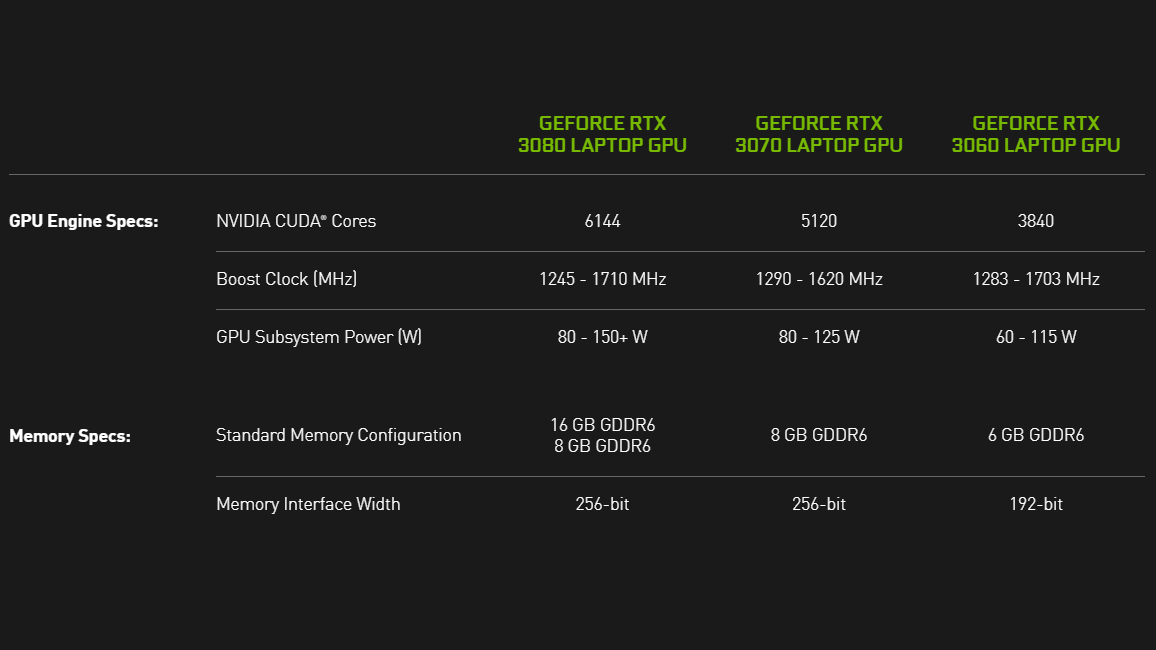Report: Nvidia Drops the Max-Q Name From RTX 30 Series Mobile GPUs (Update)
Max-Q or max confusion?
Starting with the Ampere RTX 30 series mobile GPUs, Nvidia has seemingly killed off the Max-Q (and Max-P) branding from its Geforce powered laptops, Notebookcheck reports. The Max-Q features are still here to stay, the only thing going away is the branding will be far less prominent.
titleNvie laptop could have a 70W TDP and another, 80W (implying that both laptops have the same exact GPU), but they both would be "Max-Q" certified. This certainly brings a lot of confusion to who are looking for specific performance metrics in a notebook. So killing off the Max-Q brand should help alleviate the idea that Max-Q is one subset of GPUs.
(Update, Jan 21, 4:45 p.m. ET. An Nvidia spokesperson told Tom's Hardware the following:
No, Max-Q branding is not going away.
When we originally introduced Max-Q back in 2017, the brand was initially used in GPU naming since Max-Q referred to the GPU TGP only.
Today, 3rd Generation Max-Q is broader, and is a holistic set of platform technologies and design approach to building powerful and thin laptops.
In addition, to be more transparent about a laptop’s exact capabilities, RTX 30 Series laptops now show more information than ever, listing exact TGP, clocks and features supported. You will find this in the control panel which now reports maximum power (TGP+Boost), and support for key features including Dynamic Boost 2, WhisperMode 2, Advanced Optimus, and others, all of which fall under the Max-Q umbrella.
We strongly encourage OEMs to list clocks and other technologies a laptop supports, including Advanced Optimus, Dynamic Boost 2, and more. Ultimately, like all laptop features and specs, it is up to the OEM to market what their particular laptop configuration supports.)

So from now on, the best way to check the performance of an RTX equipped notebook is to check the GPU's TDP in the notebook's spec sheet, assuming it's available there, which is often not the case. It may make it more difficult for people who want a specific option to determine what they get until they check the device manager. Simply put, the lower the TDP, the lower the GPU will perform because the GPU needs to lower clock speeds in order to stay within its designated power limit.
This information has been further expounded on by Acer's brand manager Eric Ackerson in our live talk with him during CES 2021. He commented on Nvidia's Max-Q technology and saying that Nvidia no longer provides official marketing for the Max-Q (or Max-P) brands, and that Max-Q could make some people think it's a lesser GPU without considering the efficiency the technology brings.
"There won’t be a label that indicates that on [the Acer Predator Triton 300 SE] and I don’t expect you’ll find it on others," Ackerson said. "In fact many times you might have a hard time finding information to indicate whether it’s a Max-Q or Max-P implementation of the GPU... [Nvidia doesn't] really want to call it out because there’s an assumption it’s lesser and in fact in many ways it’s greater. So we won’t be calling that out.”
Get Tom's Hardware's best news and in-depth reviews, straight to your inbox.

Aaron Klotz is a contributing writer for Tom’s Hardware, covering news related to computer hardware such as CPUs, and graphics cards.
-
cryoburner Reply...and that Max-Q could make some people think it's a lesser GPU without considering the efficiency the technology brings.
That's because they are in fact lesser cards. A 3080 Max-Q won't even perform on-par with a desktop 3060 Ti, and hardware-wise is pretty much a massively-underclocked 3070, using a far smaller chip than the desktop 3080. It's a "3080" in name only, and even with the Max-Q branding was arguably something of a scam, tricking people into thinking they are getting something comparable to the enthusiast desktop part, when in reality the desktop part gets around 50% more performance. Without the Max-Q branding, if they are just calling it a 3080 with no indication that it is something else entirely, then that's even more of a scam. At least give it some form of different naming or numbering scheme. Call it an RTX 3080M or something that makes it more clear that it's different hardware from the desktop part. -
f_u_006 I agree. This is a dishonest marketing strategy and Nvidia needs to be sued for this. Folks, lets try our best to raise awareness for this. OEMs are in this too. They didn't sold enough Turing Max-Q variants because if you check Notebookcheck.net, you'll see that a Mobile RTX 2080 Super Max-Q performs like a GTX 1660 while the Max-P variant performs very well. We really, really need to raise awareness in regards to this. A lot of novice PC gamers will be tricked into purchasing expensive laptops with Max-Q variant. This is a deliberate attempt to trick consumers!Reply -
Rdslw A lot of companies do this, last was WD with their crappy HDD's hidden between good ones, with same name.Reply
This is identical name should define performance. so if they would call it max-q35 or max-q70 then its ok (by the wattage used), for now its classic mess of hiding crappy parts between good ones. -
Kiril1512 When I bought my RTX 2080 Max-Q I knew that I will get performance of somewhat RTX 2060-2070 desktop version. I bought it in a nice sale and I need a laptop that was powerful. But I see my friends looking to a 2080 Max-Q as a equivalent to the desktop version. So even if they removed the Max-Q naming, some people will see the gpu as the same as desktop and push people to buy it.Reply -
Roland Of Gilead Replyf_u_006 said:I agree. This is a dishonest marketing strategy and Nvidia needs to be sued for this. Folks, lets try our best to raise awareness for this. OEMs are in this too. They didn't sold enough Turing Max-Q variants because if you check Notebookcheck.net, you'll see that a Mobile RTX 2080 Super Max-Q performs like a GTX 1660 while the Max-P variant performs very well. We really, really need to raise awareness in regards to this. A lot of novice PC gamers will be tricked into purchasing expensive laptops with Max-Q variant. This is a deliberate attempt to trick consumers!
Completely agree with you. The MAX Q variants are less powerful than their mobile counterparts. E.g Mobile GTX1660ti > RTX 2060 Max Q. Putting it on to the consumer to figure this out, who may not have any idea of how much a 60w/80w TDP part will perform. It's just bad form IMO.